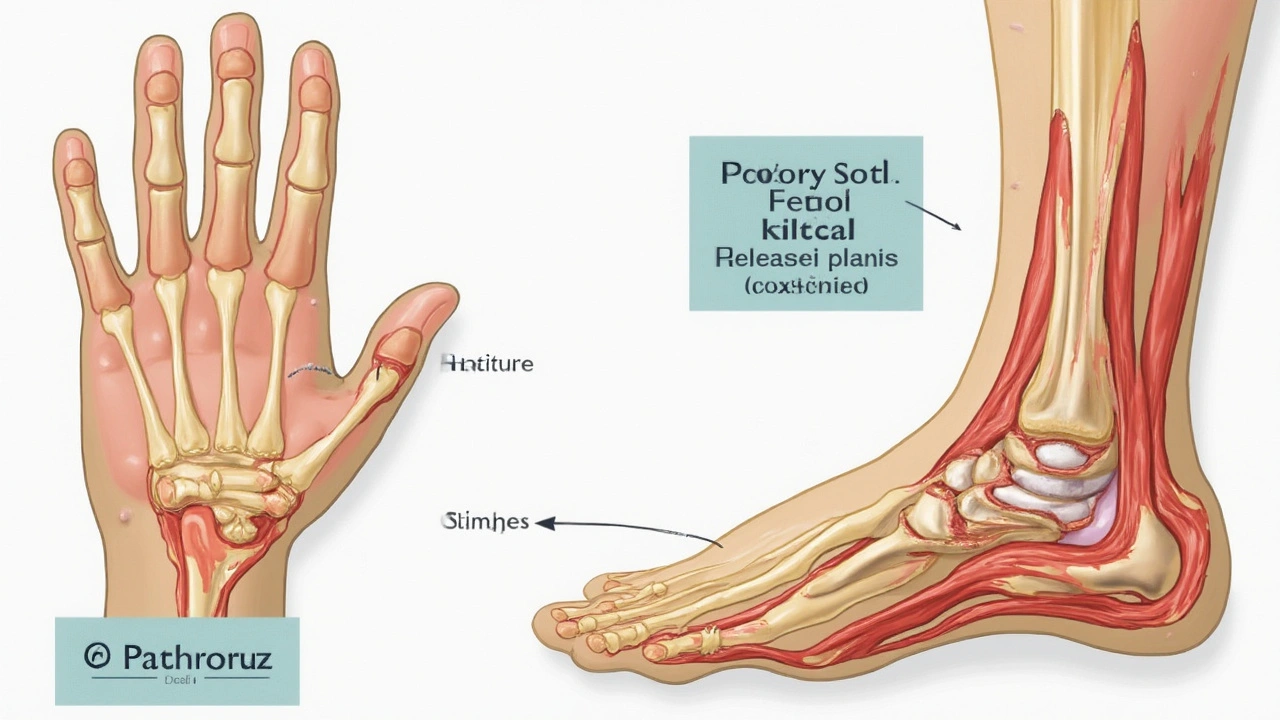Contractual Tendon Release: The Latest Breakthrough in Mobility
 Jun, 10 2025
Jun, 10 2025
If you've ever struggled to open your hand fully or flex your foot because of tight, stiff tendons, you know how frustrating simple movements can feel. Contractures can hit after an injury, due to age, or from medical conditions like cerebral palsy or diabetes. Stretching, therapy, and splints only do so much—sometimes the problem is just too stubborn.
This is where contractual tendon release steps in. Instead of waiting for slow progress, this procedure gives a fast track to better movement by releasing the tight tendon that's holding you back. Doctors use small incisions and clever techniques so you heal quicker and get moving again sooner. Patients are often surprised by how quickly they see results, sometimes even right after surgery.
- Why Contractures Happen
- How Contractual Tendon Release Works
- Candidacy and Risks
- Living With Results: Recovery and Rehab
- Real Stories & Key Tips
Why Contractures Happen
Contractures pop up when muscles, tendons, or soft tissues basically get too tight or stiff to stretch out and move as they should. This isn’t just a little soreness—it’s an actual shortening or thickening that pulls body parts into awkward positions. Most people think it happens only in older folks, but kids and adults can both get them. Some are born with them, while others develop contractures after an accident or as part of a disease.
The biggest drivers of contractures are:
- Contractual tendon release often addresses damage after an injury, surgery, or even a long time spent in a cast. If you don’t move a joint much, scar tissue can form and tighten up everything.
- Health conditions like cerebral palsy, stroke, muscular dystrophy, diabetes, and arthritis make muscles and tendons tighten and lose flexibility over time.
- Burns or skin injuries can cause scarring that contracts while healing, pulling joints and tendons out of alignment.
- Even everyday things like staying in one position for too long—think of being bedridden after a surgery—can cause these tissues to shrink up.
Check out how different causes stack up by the numbers:
| Common Cause | Percentage of Cases (Approx.) |
|---|---|
| After injury or trauma | 40% |
| Neurological conditions (stroke, cerebral palsy) | 30% |
| Immobilization (casts, bed rest) | 20% |
| Other medical conditions (diabetes, arthritis) | 10% |
Knowing why contractures happen is useful because it makes prevention and treatment way more targeted. The sooner you notice stiffness that doesn’t go away, the better your chances are of stopping the process before it gets serious enough for surgery.
How Contractual Tendon Release Works
The whole idea behind contractual tendon release is simple: loosen up a tendon that’s just too tight so your joint can move again. Doctors don’t just guess where to cut—before surgery, they pin down which tendon is the troublemaker using physical exams, imaging like ultrasound, and sometimes even nerve testing.
Most of these procedures happen under local or regional anesthesia, so you’re awake but won’t feel pain in the area. The surgeon makes a small cut—sometimes less than an inch—right above the tight tendon. Using delicate tools, they carefully snip, lengthen, or release the tendon. In some cases, special instruments let doctors reach deep spots without a big incision. The point is to loosen what’s holding your joint stiff without damaging nearby nerves, vessels, or healthy tissue.
This table shows how long different tendon release procedures typically take:
| Body Area | Average Surgery Time |
|---|---|
| Hand/Fingers | 15–30 minutes |
| Wrist | 30–45 minutes |
| Ankle/Foot | 20–40 minutes |
Sutures (stitches) are often dissolvable, so you might not even have to come back to get them out. Many doctors wrap the area and might put you in a soft splint for a few days. Some releases (like for trigger finger) are so minimally invasive that you can wiggle your fingers the same day.
Best part? The whole goal is to get you out of the doctor’s office and back to normal life—sometimes within a week, compared to months for old-school surgery. Still, you may need physical therapy to retrain those muscles and tendons so the joint stays loose and strong.
Hot tip: The fewer and smaller the cuts, the quicker you’ll bounce back, which is why more clinics use these modern minimally invasive methods. Make sure your surgeon tells you about their specific technique, recovery plan, and how soon you can get back to your regular activities.

Candidacy and Risks
Not everyone jumps straight to contractual tendon release. This surgery is usually for people who have tried physical therapy, splints, and medications but still can't move the affected joint well. Kids with cerebral palsy, adults with Dupuytren’s contracture in the hand, or those with post-surgery tendon tightness are the usual candidates. If scar tissue or long-term muscle imbalance is holding you back, this might be the next step.
Doctors check a few things before recommending surgery:
- How much movement is lost and for how long
- What caused the contracture (injury, disease, etc.)
- Overall health and healing ability
- Previous surgeries or medical treatments
Some people shouldn’t get this procedure, though. Thin skin that won’t heal, poor blood supply, or certain infections are red flags. Doctors may also avoid surgery if the joint has severe arthritis since releasing tendons won’t fix the bone problem.
Risks are real but low with today’s techniques. The biggest things to watch for are infection, nerve damage, and even accidental over-release, which could make the joint floppy. Doctors are getting smarter: studies from 2023 showed less than 5% of people needed further surgery and most didn’t have big problems. There’s also a small chance of recurrence, especially in conditions like Dupuytren’s, so you might need a touch-up years down the line.
| Possible Risks | Estimated Frequency |
|---|---|
| Infection | 2-3% |
| Nerve damage (temporary) | 1-2% |
| Over-release/floppy joint | <1% |
| Recurrence (needs another treatment) | 5-10% long-term |
The bottom line: if limited movement keeps you from daily life and other treatments aren’t working, this surgery might make a huge difference. It pays to find a surgeon who does these all the time and can walk you through your personal risk profile.
Living With Results: Recovery and Rehab
So you've just had a contractual tendon release. What happens now? The real challenge comes after surgery. Recovery isn’t just about waiting for a scar to heal. It’s about getting your function back and making sure your tendon doesn’t tighten up again.
Most people are up and moving pretty soon after the procedure—sometimes within a day if it’s a minor release. Swelling and some soreness are totally normal, especially during the first week. Docs usually encourage gentle movement almost right away to keep everything loose. You’ll probably work with a physical therapist who knows the ins and outs of post-surgical rehab.
- Contractual tendon release patients often start basic movement exercises within days to avoid stiffness and help the healing tendon glide smoothly.
- Splints or braces might be used overnight or between exercises for the first few weeks, mainly to protect the area and shape your progress.
- Typical instructions include keeping the area dry and clean, taking prescribed meds if needed, and watching out for redness or unusual pain—signs the doctor wants to hear about right away.
Physical therapy is the real game-changer here. Expect to attend regular sessions for a few weeks, maybe longer if your contracture was really stubborn. Each plan is different, but you’ll see progress tracked in how much further you can move or straighten your joint each week. Many folks report getting back to everyday stuff—tying shoes, typing, holding utensils—within four to six weeks. Kids and younger adults tend to bounce back even sooner.
| Phase | What to Expect | Rough Timeline |
|---|---|---|
| Initial Healing | Pain, swelling—basic wound care | 0-7 days |
| Early Rehab | Light movement, splinting if needed | 1-3 weeks |
| Active Recovery | Therapy, stretching, strength work | 3-6 weeks |
| Long-term Gains | Real functional use, sports/activities | 6+ weeks |
One thing nobody should ignore—doing the exercises your therapist gives you. Most setbacks happen when folks skip sessions or avoid stretching because it’s uncomfortable. If you stick with the plan, odds are good you’ll regain mobility and keep contractures from coming back. And if something feels off, don’t wait—your doctor would rather check a minor problem before it turns serious. Every case is different, but the path to better movement usually follows this pattern. Be patient and persistent, and those day-to-day wins add up fast.

Real Stories & Key Tips
Sometimes it helps to hear about real people who’ve gone through contractual tendon release. Take 42-year-old Jamie from Chicago. Years of diabetes left her right hand stuck in a curled position. Splints and therapy didn’t cut it, but after tendon release surgery, she started using her hand again within a couple weeks. She still does daily exercises, but she says buttoning a shirt is finally possible—and pain-free.
In another case, Anthony, a high school pitcher, injured his ankle and developed contracture. Doctors offered contractual tendon release after rehab stalled out. Three months after the procedure, he was back on the mound for his senior season. His advice? “Follow the rehab—don’t skip the stretching, and ask for help if you get stuck.”
| Outcome | Percentage of Patients |
|---|---|
| Regained significant mobility in 1 month | 79% |
| Pain noticeably reduced after 2 weeks | 67% |
| Returned to daily activities within 8 weeks | 85% |
| Needed revision surgery | 5% |
Want to make the most of your recovery? Here are a few tips straight from patients and therapists:
- Stick to your exercises, even if your hand or foot feels great right away. Skipping rehab makes setbacks more likely.
- Keep your incision clean—most infections happen because people get careless.
- Ask your surgeon about forming scar tissue. Massaging the area and moving often can help avoid extra stiffness.
- Let your doctor know ASAP if something feels off, especially tingling or new pain. Early action can save you extra trouble.
- If nerves about surgery are holding you back, ask if you can talk to a former patient. Hospitals often connect people for first-hand advice.
Recovery is different for everyone, but you don’t have to go it alone. The first few weeks are usually the hardest, but that’s when the biggest changes happen. Use reminders, get your family involved, and don’t hesitate to reach out to your care team with questions—even if they seem minor.
